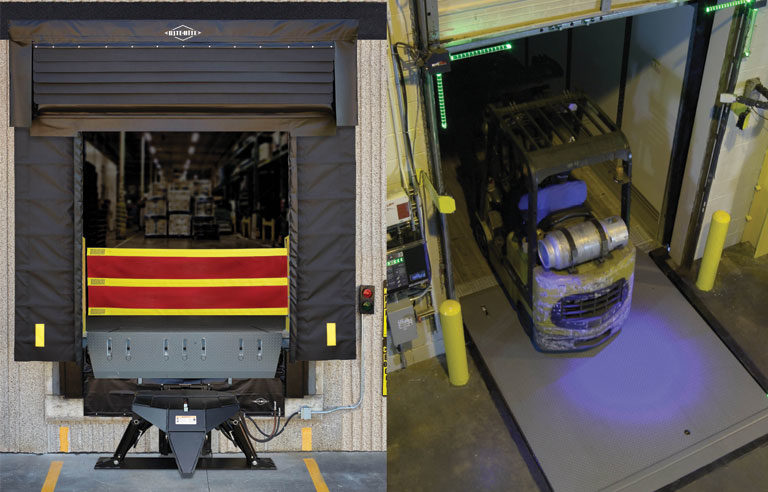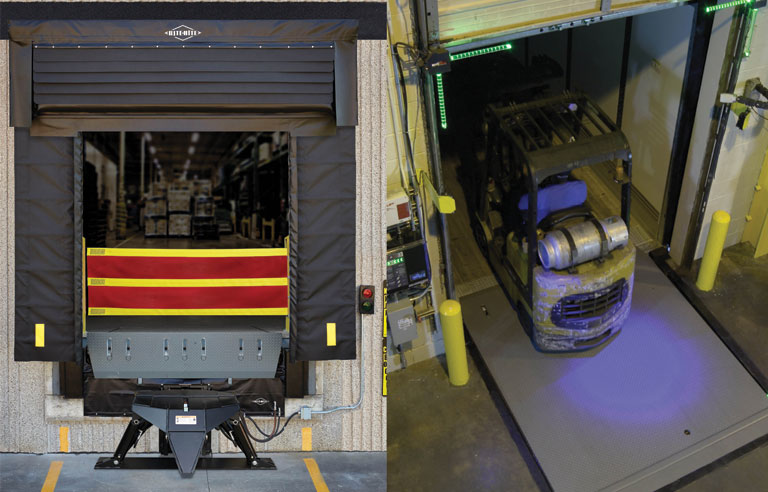Locked In, Smoothed Out: Loading Dock Safety


Loading docks are busy places – and hazards are everywhere. Dock personnel exposed to crushing threats and repetitive, manual tasks are at serious risk for chronic, life-altering injuries.
Material handlers are at risk of falling or rolling off the edge of the loading dock, while loading dock equipment is susceptible to damage from trailer separation accidents as well as being improperly maintained or outdated. Investing in the proper loading dock equipment for your application is critical to facility safety. Learn how safety solutions from Rite-Hite help mitigate these unsafe loading dock trends.
Whole body vibration
Loading dock levelers are crossed more than 100 times a day. Every time a forklift crosses over the leveler from the warehouse and a trailer, each bump exerts pressure up through the bottom of the forklift and into the driver’s spine, shoulders and neck. If a dock leveler is aged or undermaintained, operators may experience a jarring, whole body vibration known as “dock shock.”
By creating smoother transitions from leveler to trailer (and vice versa), Rite-Hite’s ergonomically designed levelers can alleviate whole body vibration, reducing dock shock by up to 50% when paired with modern forklift designs and by more than 120% when added to a stabilizing trailer restraint.
Manual, repetitive tasks place workers at risk
Loading dock equipment is heavy. In fact, it can take between 55 and 70 pounds of pull chain force to lift a mechanical leveler that can weigh up to 2,500 pounds. Manually operating loading dock levelers and doors or placing wheel chocks on the drive approach places operators in harm’s way and can lead to immediate injuries or chronic pain.
Investing in loading dock equipment, such as hydraulically operated levelers, with simple push-button operation automates these manual, repeatable operations as well as helps ensure workers stay at the control box and off the dangerous drive approach. Going a step further by incorporating safety products with sensors, LED lights, audible/visual alarms and interlocked safe sequence of operations helps ensure safety protocols and processes are followed by dock workers and material handling personnel.
Forklift accidents
7% of reported forklift accidents are a result of driving off the edge of the loading dock, which create a 4-foot drop-off whenever trailers aren’t present or safely restrained. Facilities are at greatest risk for drop-off accidents when:
- Trailers aren’t present.
- Trailers aren’t properly secured to the building.
- During warm weather, when dock doors are left open for increased airflow.
Loading dock safety barriers, such as the Safe-T-Lip® leveler lip or Dok-Guardian®, help to protect pedestrians and forklifts from rolling or falling off the edge of the loading dock.
Forklift accidents caused by the early departure or unplanned separation of a semitrailer from a loading dock have consistently remained a top concern at warehouses and distribution centers.
Although trailer separation accidents still occur, investing in equipment that safely secures the trailer to the dock helps to minimize these risks. Offering the greatest reach, creating a two-point entrapment or ICC bars and today’s RIGs, Dok-Lok® rotating hooks help reduce trailer separation accidents such as early departure, trailer creep, landing gear collapse and more. When optimized with Shadow Hook® Technology, rotating hook vehicle restraints can properly secure intermodal chassis as well as obstructed RIGs.
Conclusion: Although all safety begins with proper training, safety equipment and systems are also critical. Installing loading dock equipment – such as vehicle restraints, hydraulically operated levelers and communication systems – helps to secure your loading dock, mitigate hazards, and help improve safety conditions for your facility and your personnel.
Post a comment to this article
Safety+Health welcomes comments that promote respectful dialogue. Please stay on topic. Comments that contain personal attacks, profanity or abusive language – or those aggressively promoting products or services – will be removed. We reserve the right to determine which comments violate our comment policy. (Anonymous comments are welcome; merely skip the “name” field in the comment box. An email address is required but will not be included with your comment.)

